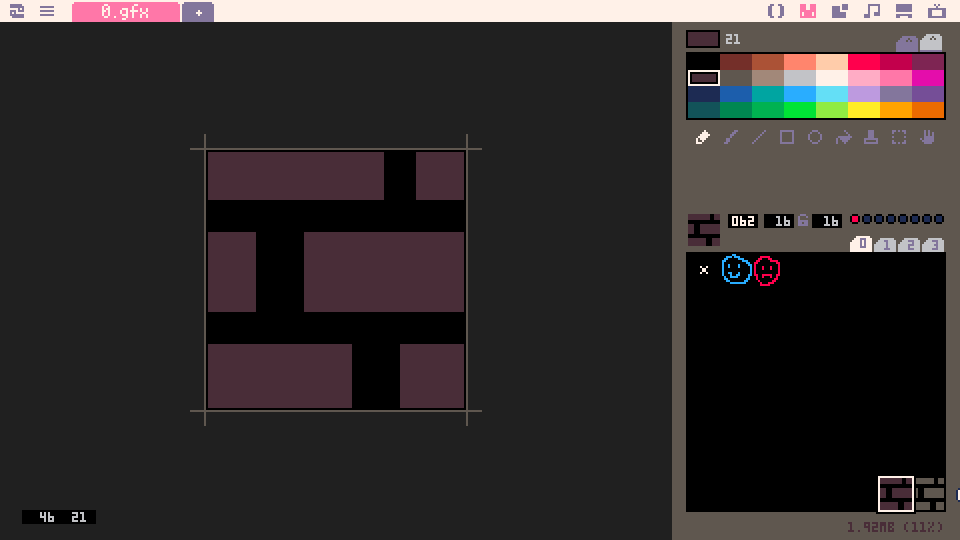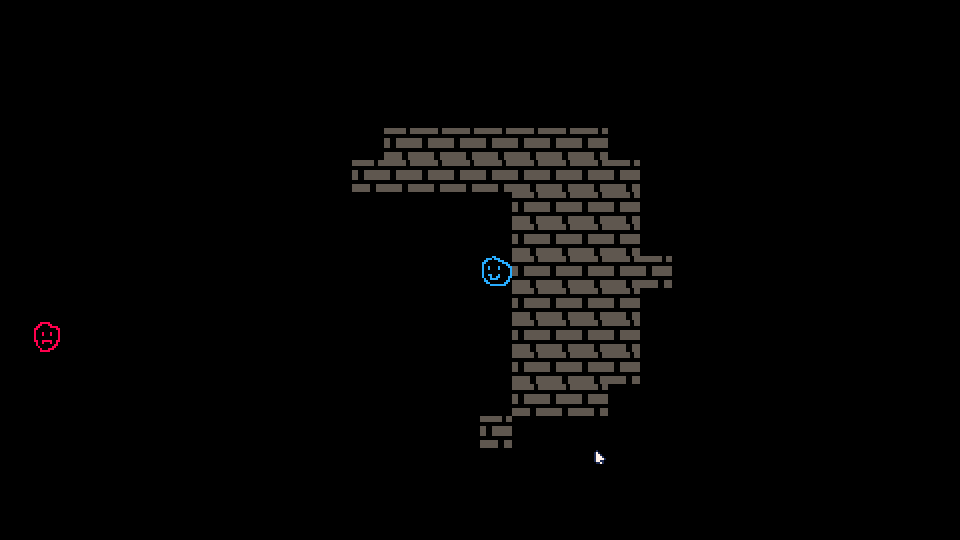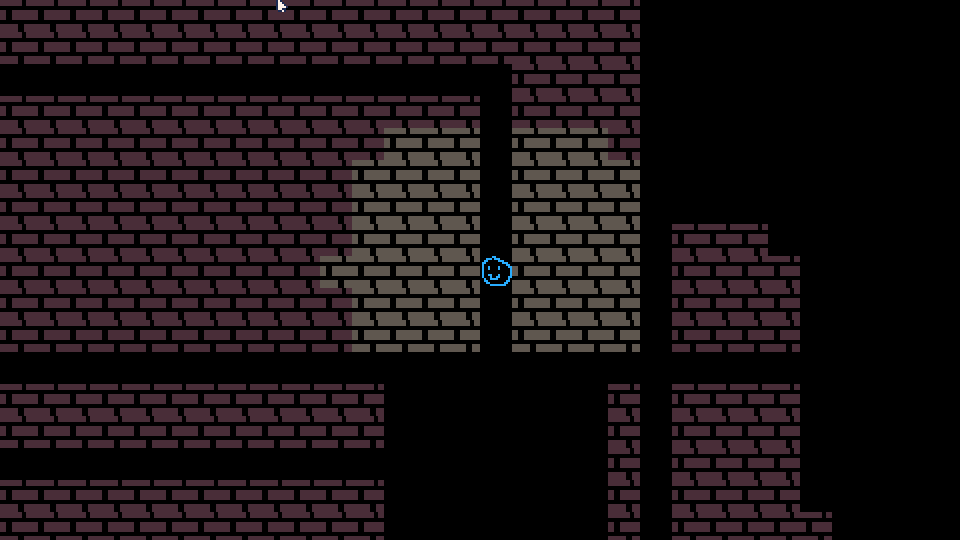Picotron Roguelike Tutorial
A tutorial for making a basic roguelike using Picotron
Project maintained by seawaffle Hosted on GitHub Pages — Theme by mattgraham
Part 4: Field of View
In Part 3, we generated a whole dungeon and displayed it on the screen. But that’s not really the vibe we want in our roguelike, right? Roguelikes are supposed to be about exploring and not knowing what terrible bad guy is right behind the corner! So let’s make it so that we only draw what the player can see, or has explored. Let’s start by making a new sprite for a wall that we’ve seen, but can’t currently seen.

All I’ve done here is change the color of the wall sprite to a different darker color. It’s not the best, but I think it’ll work out ok.
Now, we’ve been using the Picotron map to store our map, but that doesn’t work out so well when you want to hide portions of it. So we’re going to modify mapgen.lua to store our information about the base structure of a map in a table, then we’ll use that to set our map tiles at draw time.
-- mapgen.lua
floor = 0
seenWall = 62
wall = 63
mapTiles = {}
...
function populateMap()
-- generate a random amount of rooms
local rooms = {}
for count = 0, maxRooms do
local width = generateRandomNumber(minSize, maxSize)
local height = generateRandomNumber(minSize, maxSize)
local posX = generateRandomNumber(0, mapWidth - width - 1)
local posY = generateRandomNumber(0, mapHeight - height - 1)
local room = RectRoom:new(posX, posY, width, height)
local good = true
-- if the room intersects with another, we're going to toss
-- it out and keep going
for otherRoom in all(rooms) do
if otherRoom:intersects(room) then
good = false
end
end
if good then
add(rooms, room)
end
end
-- fill all map tiles with wall, except for tiles that are in a room
for y = 0, mapHeight do
for x = 0, mapWidth do
local tile = wall
local index = (y * mapWidth) + x
for room in all(rooms) do
if room:inRoom(x, y) then
tile = floor
end
end
mapTiles[index] = tile
end
end
-- tunnel between all rooms
for index = 1, count(rooms) - 1 do
local room1 = rooms[index]
local room2 = rooms[index + 1]
tunnel = cocreate(tunnelBetween)
while costatus(tunnel) != "dead" do
local status, curr = coresume(tunnel, room1, room2)
if costatus(tunnel) != "dead" then
local index = (curr.y * mapWidth) + curr.x
mapTiles[index] = floor
end
end
end
end
So now, we’re dumping our tile values into mapTiles instead of directly writing them to Picotron’s map. We’re indexing all of our tiles using the simple equation: (y * mapWidth) + x. This lets us put all of our tiles into an a single line, essentially. Don’t run this yet, you’d get a black screen with your player on it. We’ve still got a ways to go. Let’s make a new file and call it ‘fov.lua’.
-- fov.lua
visible = {}
seen = {}
visionRadius = 5
function updateFOV()
for y = 0, mapHeight do
for x = 0, mapWidth do
local tile = {x=x, y=y}
local index = (y * mapWidth) + x
if insideCircle(player, tile, visionRadius) then
visible[index] = true
seen[index] = true
else
visible[index] = false
end
end
end
end
function insideCircle(center, tile, radius)
local dx = center.x - tile.x
local dy = center.y - tile.y
local distanceSquared = (dx * dx) + (dy * dy)
return distanceSquared <= (radius * radius)
end
Here, we’ve got a couple tables that are going to hold whether a tile is visible or seen. Our FOV is simply a circle (the logic for which I’ve stolen from Red Blob Games), and essentially, we are omniscient within that five-tile radius. It’s not the best way of handling it, but Picotron has no tools built in for that sort of stuff, and I’m sort of lazy and itching to get back to dying in DCSS.
So, now we’ve got our map generation set up to work in this new way, and we’ve got our super-complex FOV algorithm, so let’s get to stitching it all together. Head over to main.lua.
-- main.lua
include "utilities.lua"
include "entities.lua"
include "mapgen.lua"
include "fov.lua"
...
function _update()
if btnp(0) then
player:move(-1, 0)
elseif btnp(1) then
player:move(1, 0)
elseif btnp(2) then
player:move(0, -1)
elseif btnp(3) then
player:move(0, 1)
end
updateFOV()
updateMap()
end
function updateMap()
for y = 0, mapHeight do
for x = 0, mapWidth do
local tile = floor
local index = (y * mapWidth) + x
if mapTiles[index] == wall then
if visible[index] then
tile = wall
elseif seen[index] then
tile = seenWall
end
end
mset(x, y, tile)
end
end
end
...
We’ve modified our _update function to finally do something other than handle player input. After the input section, we call off to updateFOV, which will take the player’s (possibly new) position and figure out what tiles are visible. Then, we call updateMap which translates the values in all of our new tables (mapTiles, visible and seen) into what we should be displaying for each tile on the map, and then sets those values in the Picotron map. Before we run this, there’s one last piece that I almost forgot. Let’s look at entities.lua:
-- entities.lua
function findEmptySpot()
while true do
local posX = generateRandomNumber(0, mapWidth)
local posY = generateRandomNumber(0, mapHeight)
local index = (posY * mapWidth) + posX
if mapTiles[index] == floor then
return posX, posY
end
end
end
We’re changing findEmptySpot to refer to the mapTiles table, because at the time that we call this, the Picotron map is set to all floor tiles, and isWalkable still refers to the Picotron map. With all that handled, let’s run this thing.

Looking good. You might notice something in that clip, or while you’re walking around your dungeon. Our NPC isn’t really following the rules of our FOV. Makes sense, since we haven’t modified any of our draw code to handle that. Let’s get to that now, over in main.lua.
-- main.lua
...
function _draw()
cls()
camera(player.x * 16 - 15 * 16, player.y * 16 - 8 * 16)
map()
drawEntities()
end
function drawEntities()
for entity in all(entities) do
if entity == player or insideCircle(player, entity, visionRadius) then
entity.draw()
end
end
end
Not a whole lot new here. We’ve moved our entity-drawing logic out of _draw and into a new function called drawEntities. We do the same loop, but this time for each entity we check to see if it’s either the player or in the player’s vision circle. If so, we draw it, if not, we let them stay invisible. Here it is in action:

Everything looks like it’s in order! You can give it a try online here. Our dungeon now has the appropriate amount of spooky ambiance we’re looking for, with enemies lurking just beyond our torchlight. I’m beat, time for another break. I’ll see you again in Part 5!